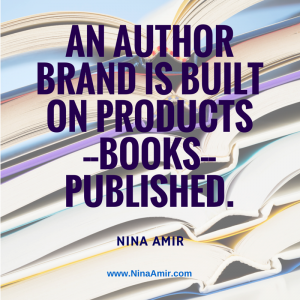Wednesday, April 22, 2015

Photo courtesy of iqoncept | stockfresh.com.
Branding seems like an activity best suited to companies, like Nike, Audi, Best Buy, Rolex, or Amazon. Books and words brand nonfiction authors, right? And they do so in an authentic and organic manner.
In fact, authors do need brands, but most writers don’t think about branding—or don’t want to think about it. Those writers who do bother to brand themselves typically wait until they become authors or have been published for a while.
In both cases, this is a mistake. Serious nonfiction writers who want to succeed as authors should include branding in their early success planning.
A strong brand helps an author in the same ways it helps a company. It gives you name recognition…Click To Tweet
That means branding should be part and parcel of the business plan you write when you first get the idea for a book. In fact, that idea for your first book quickly should be followed by a brainstorming session for spin-off books or a series and a big-picture view of who you want to be and how you want to be known when you become an author.
More specifically, follow these six steps to quickly develop your author brand.
1. Determine how you want to be known.
Branding is a large topic. There are whole books written about it. Branding experts help other people and businesses develop their brands. However, it’s possible even for someone like you, a nonfiction writer or author, to create a brand with just a little bit of knowledge.
Here’s how you start: Think about how you want to be known as a writer. To determine this, consider:
- the types of writing you want to do
- the subjects about which you want to write
- the types of stories you want to tell
- the themes you want to cover in your work
- the ways in which you want to serve you readers
- the clients or customers you want to attract
- the spin-off books (sequels or series) you would like to publish
- your values
- your interests
- your passion
- your purpose
Does something stand out? Is there one quality, topic or aspect you’d like to highlight so that you become known for it? If so, this is a good place to start. You then can create logos, taglines and websites that feature and highlight this concept so you become known for it. This becomes your brand.
Or try to answer this question: “How would I like to be known?” Do you want to be “The ___ Coach,” “The ___ Writer” or “The ___ Expert,” for example? Or will you brand around your name alone?
2. Decide what books you will write.
Another way to brand yourself is by writing more than one nonfiction book about a certain topic or theme.
You can brand yourself by writing many nonfiction books (or novels) about a certain topic or theme. Click To Tweet
Your spin-offs and series will highlight who you are and what you write about.
To brand yourself in this manner, brainstorm the different nonfiction books you might write. Then take a “big picture” view of this material:
- How do these books fit together? By a theme or a subject?
- Can you group any of them together?
- Can you find one overriding thread that holds them together?
- Can you describe that thread (or theme) in one sentence or in a phrase?
- Can this become your “branding statement”?
Here again, you could become know as “The ___ Writer.” Think of the knitting writers and the Amish romance writers, for example.
3. Create a website or blog that helps build or strengthen your brand.
You can support or develop your brand with a website or blog. A blog works as a website, and every author needs an “author website.”
Purchase a URL with your name so readers and the media easily can find you. However, if you also are branding with a tag line or some sort of expert status, you may want to purchase that URL and redirect to it as well.
Then design your site with colors, words, phrases, and images that make it easy for someone to know “what you are about.” Your site’s title and tagline should make this clear as well. For example, Michael Hyatt’s title and tagline are “Your Virtual Mentor. Win at work. Succeed at life.” That’s pretty clear branding. Additionally, write lots of posts on topics or themes related to your brand to help strengthen it and make your site more discoverable by readers doing searches. Again, Hyatt’s site is a good example of this.
People who visit your site should immediately “get it.” They should understand what you stand for, what you write about and any other messages you want to get across. Here are a few sites to check out:
- L. Stine. He’s done a fabulous job of branding himself with a website. He’s even used music!
- Cindy Woodsmall’s website. No question what she writes about.
- Jack Canfield’s message is enormously clear right from his banner and throughout all his content and products and services.
4. Use your brand statement across all your social networks.
Use the same title, tag line, photo and colors, etc., across all your social networks, as well as in articles, videos, and guest post, and always provide a link “home.” This helps you get you known quickly and easily and is another way to strengthen your brand once you’ve developed it. And tie everything you do back to your author website.
Carla King has used her “adventuring” brand across all her social networks as MissAdventuring. Her books and websites help her strengthen her brand as well.
5. Ask others for help.
If you have difficulty creating a brand for yourself, ask those who know you best for help. Ask readers, clients, customers, and friends the following:
- What do you perceive as my values?
- What do you consider my strong points?
- What do I do for you?
- What benefit do you get out of my books, work, courses, products, or services?
- How would you describe me?
Take this information—if you like what you hear and it works for you—and craft it into a brand. If you don’t like what you hear, it’s time to think about how to create a different perception than you haphazardly have done in the past.
6. Create an umbrella for all you do—even if you do a lot.
It can be easier for nonfiction writers than fiction writers to develop brands. Yet, many nonfiction writers choose to write about a variety of topics, and this can make it difficult for them to brand themselves as well. However, it’s still possible to find an “umbrella theme” to tie everything together into a brand even if you write about two or three subjects or write across genres.
If you write fiction as well as nonfiction, you might write novels that appear to be unrelated. Or you could weave similar themes, topics, issues, or locations into your nonfiction and your nonfiction. For example, think about weaving your love of orchids into both your momlit and your thrillers. Then write nonfiction books about growing orchids. That could brand you.
 Your momlit could have a main character that runs an orchid shop.
Your momlit could have a main character that runs an orchid shop.- Your thrillers could have a main character that leaves orchid blooms at the scene of the crime.
- Your nonfiction could focus on orchid care.
Or all your books could take place in England or could discuss family values or politics. You could draw on your law degree or your former life as a nurse.
If you write nonfiction about organic gardening, travel and business, you might be able to write books that:
- Eating organic in foreign countries
- Organic business practices
- New organic gardening techniques
Of course, the more books you write with these themes or elements in place, the stronger your brand becomes. By choosing something—like orchids or organics—to run through all your books, you strengthen your brand with every title you release. And don’t forget to place a picture of an orchid or an organic garden on your website and use that word in your tag line. Write blog posts about orchids and organics. Before long, everyone will know you as the Orchid Author or the Organic Author. That’s branding.
Sell More Nonfiction Books with a BrandWhy bother branding? For the same reasons big box and small box companies bother: It helps sell products. A brand helps potential readers know, like and trust you.
And remember:
Your brand is you. It’s a way to help readers know you—authentically. Click To Tweet
You aren’t creating some fake ad or new persona. Your brand helps readers understand who you are and what you and your nonfiction books stand for—and what type of books you write. That makes it easier for them to decide to purchase those books. That means your books will get read. And that’s the ultimate goal.
Get help with your author branding when you click here.The post
6 Steps to Creating Your Author Brand appeared first on
Write Nonfiction NOW!.
Nina Amir, the bestselling author of How to Blog a Book and The Author Training Manual, is a speaker, a blogger, and an author, book, and blog-to-book coach. Known as the Inspiration to Creation Coach, she helps creative people combine their passion and purpose so they move from idea to inspired action and positively and meaningfully impact the world as writers, bloggers, authorpreneurs, and blogpreneurs. Some of Nina’s clients have sold 300,000+ copies of their books, landed deals with major publishing houses and created thriving businesses around their books. She is the founder of National Nonfiction Writing Month, aka the Write Nonfiction in November Challenge, and the Nonfiction Writers’ University. She has had as many as four books on the Amazon Top 100 List in the Authorship category at the same time.